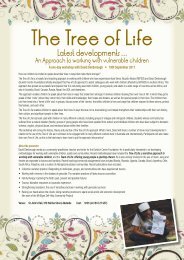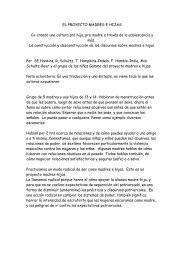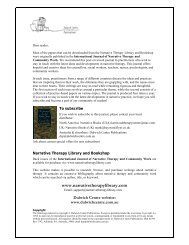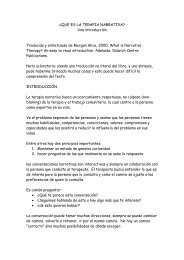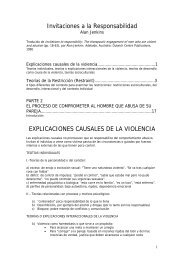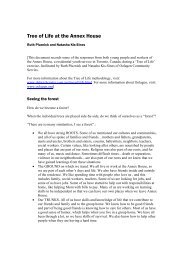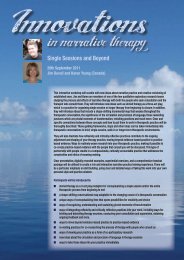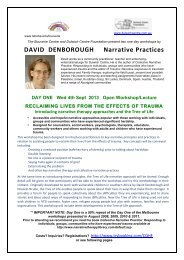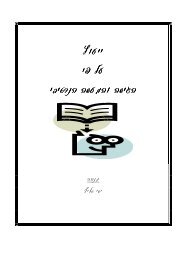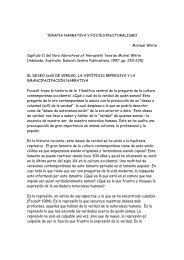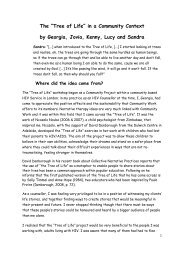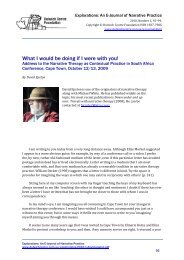Studying narratives: A review - Dulwich Centre
Studying narratives: A review - Dulwich Centre
Studying narratives: A review - Dulwich Centre
You also want an ePaper? Increase the reach of your titles
YUMPU automatically turns print PDFs into web optimized ePapers that Google loves.
Explorations: An E-Journal of Narrative Practice2010, Issue 2, 95–98. Copyright © <strong>Dulwich</strong> <strong>Centre</strong> FoundationISSN 1837–798X www.dulwichcentre.com.au/e‐journal.html<strong>Studying</strong> <strong>narratives</strong>A <strong>review</strong> of the book Analyzing narrative realityby Jaber F. Gubrium & James A. Holstein (2009).By Tom StrongTom Strong is a Professor and counsellor‐educator at the University ofCalgary who writes on the collaborative, critical and practical potentialsof discursive approaches to psychotherapy. Author or co‐author of over70 articles and chapters, and co‐author (with Andy Lock) of Socialconstructionism: Sources and stirrings in theory and practice (CambridgeUniversity Press). His other books include Furthering talk (with DavidParé), and the forthcoming Discursive perspectives on therapeutic practice(co‐edited with Andy Lock for Oxford University Press). Tom’s website isaccessible at http://www.ucalgary.ca/strongt. Tom Strong can becontacted at: Dr. Tom Strong, Division of Applied Psychology, Universityof Calgary, 2500 University Drive NW, Calgary, Alberta Canada T2N 1N4or email: strongt@ucalgary.caIf storytelling is a collaborative activity, how do we know who owns a story? (Gubrium& Holstein, 2009, p. 107)Narrative therapy has always had an elder sibling in narrative research. The notion fromthe humanities that stories gave personal, social, and cultural meaning and organisation topeople’s lives is longstanding. But it was only in the 1960s that narrative analysis found itstributaries in a confluence of linguistics (for example, Labov & Waletzky, 1967) and literarytheory (for example, Barthes, 1986). Later, as performance‐focused anthropologists like RichardBauman (1986) and conversation analysts, like Gail Jefferson (1978) brought their approachesto studying narrative, this area of scholarship seemed to teem with possibilities. In more recenttimes, distinct narrative research approaches have burgeoned to a point best exemplified byJean Clandinin’s (2007) massive (720 pages) edited tome, The handbook of narrative inquiry. So,it can be a relief to see seasoned qualitative researchers, like Gubrium & Holstein (2009), stepinto this sprawling diversity to pull out a coherent and useful narrative about studying<strong>narratives</strong>.Explorations: An E-Journal of Narrative Practicewww.dulwichcentre.com.au/explorations-2010-2-tom-strong.pdf95
Before going any further, I need to acknowledge that narrative therapists tend to havefinely attuned critical radar for words like ‘reality’ found in this book’s title. They also havedeveloped a considerable wariness for the truth claims made by researchers, and how suchclaims are used as warrant for questionable prescriptions. Relax, you will feel at home in thepoststructuralist approach taken by these authors who have authored or edited many booksthat will resonate with postmodern readers (for example, Gubrium & Holstein, 2007). You mayalso find many ideas and practices that expand your sense of narrative therapy’s pragmatics andpossibilities. I will confess to poaching ideas for therapeutic practice for some time fromqualitative research (for example, Strong, 2002), and Gubrium & Holstein’s volume is a goodplace for you to consider starting a similar practice yourself.Why would I suggest that a book intended for narrative researchers might prove aworthwhile read for narrative therapists? My short answer would be that both narrativeresearchers and narrative therapists have drawn on a common body of ideas to inform theirrespective, somewhat overlapping, approaches to practice. The overlap obviously comes withan interest in advancing the potentials of narrative as a means for understanding and action. Myqualifier, ‘somewhat’ (that is, ‘somewhat overlapping’), refers to some useful distinctionsGubrium & Holstein raise that I think can supplement what narrative therapists customarilybring to their interactions with clients and community groups. In the course of their book,readers gain a sense of how the narrative metaphor caught on across the social sciences, takingus to what contemporary narrative researchers now consider important elements of goodnarrative research.I should first address the ‘r’ word in the book’s title. Reality, as it is used here, is the socialreality associated with what phenomenologists have long called ‘the natural attitude’. By this,we are talking about the linguistically‐enabled understandings people use in unquestioned ways(to varying degrees) to make their way through life. Our stories and the words they arecomposed of are stand‐ins of varying effectiveness and suitability for how we make sense of ourexperiences and each other. Such narrative sense‐making is acquired in and through encounterswith others’ stories and word usage. For Gubrium & Holstein, this extends to the shaping ofpersonal stories from cultural and institutional stories. Narrative reality has no meaning beyondthe varied social and cultural conversations in which such shaping occurs, and individuals arenot merely ventriloquated by the stories around them either. There is no sense here thatnarrative researchers can objectively and ultimately adjudicate the correctness, veracity,suitability and so on of <strong>narratives</strong> for others. Instead, narrative reality is treated as the infinitelyvariable ways individuals and people‐in‐relationship make sense of their past, present andfuture experiences. The conversations from which such <strong>narratives</strong> are elicited offer dataconsidered as real to narrative researchers as so‐called objective measures used in ‘hardsciences’ such as biomedicine. What matters to Gubrium & Holstein, and why I thought I’d writethis book <strong>review</strong>, relates to their emphasis on how researchers (and narrative therapists)occasion and co‐compose, with research participants, the stories they treat as the real data theywork with.Late in their book, Gubrium & Holstein refer to a story’s ‘borders’. By this word, they aredrawing attention to how any narrative’s life must be considered in terms of the conversationsthat flow into and out of a narrative. Seen against the flux and flow of life’s experience,<strong>narratives</strong> are abstractions from, and impositions on, such experience. So, they’d better be aptand useful <strong>narratives</strong>. Narratives are hardly ready‐made; they are kept the same, modified, ordiscarded in conversations. Thus, one focus of Gubrium & Holstein’s narrative researcher is onaccounting for how <strong>narratives</strong> develop contextual and conversational lives from, not only thenarrative environments in which they acquired their sense (their natural habitats so to speak),Explorations: An E-Journal of Narrative Practicewww.dulwichcentre.com.au/explorations-2010-2-tom-strong.pdf96
ut also from how the researcher’s questions occasion or elicit participants’ <strong>narratives</strong>.Narratives, in other words, cannot be studied apart from the conversations in which they findtheir meaning. Rest assured that meaning isn’t something the narrative researcher determinesapart from participants either. The ‘borders’ of <strong>narratives</strong>, as much as their content, can be, asGregory Bateson (1980) would say, odd ways to punctuate reality. However, <strong>narratives</strong> are howpeople make sense of and organise what’s real in their lives. The narrative researcher’s job is tohighlight these human constructions, including their own part in ‘activating’ them.For me, the most interesting section of this accessible book was on ‘narrative work’. HereGubrium & Holstein write of how <strong>narratives</strong> are ‘activated’, how conversation, and particularlyhow questioning and listening, not only enable accessing <strong>narratives</strong>, but help them get ‘talkedinto being and significance’. This is a perspective drawn from ethnomethodology andconversation analysis (for example, Heritage, 1984), one focused on what is accomplished inand through social interactions like research interviews. Not only are such participant<strong>narratives</strong> ‘activated’, however; in the activation a careful interviewer hears ‘linkages’ that theauthors caution interviewers not to assume are from the private recesses of the participant’s (orclient’s) mind. The challenge here is to link the narrative occasioned in the interview to thebroader cultural and institutional stories informing it. In the sense described here, participant<strong>narratives</strong> are not simple either, as in a re‐enactment or re‐telling of these broader stories, aslinkages in today’s postmodern world are not just to one story, but to hybrids that draw on themultiple stories in which participants participate and make sense of their experiences. Further,the researcher effectively smuggles his or her own stories, via questions asked, into thenarrative‐in‐the‐making. This raises ‘composition’ concerns for our authors.In ‘narrative work’, researcher and participants are composing <strong>narratives</strong> ‘beyond thelinkages in tow’ (Gubrium & Holstein, 2009, p. 75) that feature the agency of the storyteller. Thisreads a lot like narrative therapists’ ethical concerns (for example, Weingarten, 1992) for whosestory gets co‐authored in the course of therapeutic dialogue. Considerable attention is given tothe performance of research <strong>narratives</strong> for how they are enacted with participants holding theconversational floor, controlling their plotlines, while recognising that researcher questions andresponses (right down to the nonverbals) play a role in a resulting narrative and its enactment.‘Collaboration’ is unsurprisingly a chapter unto itself in the ‘narrative work’ section of the bookand the authors remind us that we need to dispose of the ‘individual ownership view of stories’(p. 104), and to instead orient to our role in any story’s telling.Gubrium and Holstein’s last major section in the book is on ‘narrative environments’. Theyremind us that all human contexts are story‐making, story‐retaining environments, and howdiverse yet overlapping the stories taken up in these contexts can be – even, for example, withinthe same families. It is within such narrative environments that <strong>narratives</strong> accord status tothose articulating and articulated by them. We are all implicated in and by the moral status andintentions bestowed on the actors within such <strong>narratives</strong>. Among the <strong>narratives</strong> findingattention in this book are families, cultures, jobs and organisations. Drawing frompoststructuralist literary theorists, the authors even devote a chapter to ‘intertextuality’ todemonstrate how, in effect, all <strong>narratives</strong> draw from more than one interpretation or story forexperience. Rich case examples to illustrate the points made are offered here and throughoutthe book.The book closes with two potentially controversial chapters: ‘What is a good story?’ and,‘Who is a good storyteller?’ This was as close to prescriptions as the authors got. But what theyprescribe will fit with most readers here: 1) document indigenous categories for whatconstitutes narrative adequacy (my translation: ask participants if your version of the storyequals theirs, and let yourself be corrected), 2) the <strong>narratives</strong> derived from research must beExplorations: An E-Journal of Narrative Practicewww.dulwichcentre.com.au/explorations-2010-2-tom-strong.pdf97
compelling or entertaining in ways true to participants, and 3) the <strong>narratives</strong> were useful inorganising thoughts, feelings and planning, while providing a rich account of experience. The‘good storyteller’ part tweaked my therapist radar. Participants are truthful and consistent,offering accounts that help shape the research narrative. In therapy, such truthfulness andconsistency is sometimes a procedural development from a relationship in which clients learnto trust and appreciate their therapist’s role as co‐author.Overall, this book offered the narrative therapist in me confirmation of the utility andubiquity of narrative as an organiser of thought and behaviour. It also reminded me of some ofmy own discursively‐oriented research into narrative therapy practice (Strong, 2008), whereinwhat Gubrium & Holstein described as co‐composition, can be seen as an intricateconversational dance of therapist and client initiatives and responses to each other. It does notoffer the kind of read one might get from the books or articles of key narrative therapy authorpractitioners.But, that is where the book offers what Bateson (1980) requires for a kind ofbinocular vision, by juxtaposing one’s normal reading of the narrative therapy literature with aresearcher’s view of doing good narrative work.ReferencesBarthes, R. (1986). The death of the author. In R. Barthes (Ed.), The rustle of language (R. Howard, Trans.)(pp. 49–55). New York, NY: Hill and Wang. (Original published in 1968.)Bateson, G. (1980). Mind and nature: A necessary unity. New York, NY: Bantam.Bauman, R. (1986). Story, performance, and event: Contextual studies of oral narrative. New York, NY:Cambridge University Press.Clandinin, D. J. (Ed.) (2007). The handbook of narrative inquiry. London, England: Sage.Gubrium, J., & Holstein, J. (Eds.) (2007). The handbook of constructionist research. New York, NY: Guilford.Gubrium, J., & Holstein, J. (2009). Analyzing narrative reality. London, England: Sage.Heritage, J. (1984). Garfinkel and ethnomethodology. Cambridge, England: Polity Press.Jefferson, G. (1978). Sequential aspects of story telling in conversation. In J. N. Schenkein, (Ed.), Studies inthe organization of conversational interaction (pp. 213–48). New York, NY: Academic Press:Labov, W., & Waletzky, J. (1967). Narrative analysis. In J. Helm (Ed.), Essays on the verbal and visual arts(pp. 12–44). Seattle, WA: University of Washington Press.Strong, T. (2002). Collaboration, meaning‐making and therapy: what practitioners can learn from recentdevelopments in qualitative research. Review of The handbook of qualitative research (2nd ed.). In N.Denzin & Y. Lincoln (Eds.), Counselling and psychotherapy research, 2(3), 209–211.doi:10.1080/14733140212331384845Strong, T. (2008). Externalising questions: A micro‐analytic look at their use in narrative therapy. TheInternational Journal of Narrative Therapy and Community Work, (3), 59–71.Weingarten, K. (1992). A consideration of intimate and non‐intimate interactions in therapy. FamilyProcess, 31(1), 45–59. doi:10.1111/j.1545‐5300.1992.00045.xExplorations: An E-Journal of Narrative Practicewww.dulwichcentre.com.au/explorations-2010-2-tom-strong.pdf98



